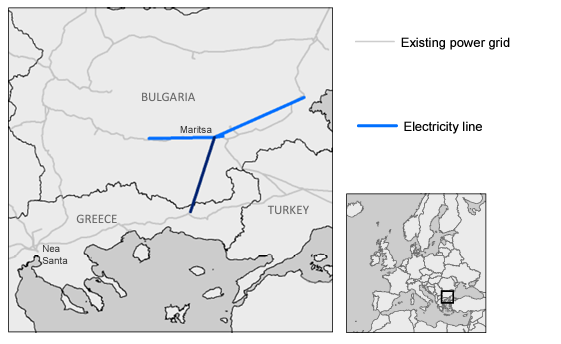This Good Practice article highlights the achievements of cross-border cooperation between two Balkan neighbors in the energy sector. Over the past couple of decades, Greece and Bulgaria have been implementing strategies of joint efforts to increase their energy exchange capacity by creating electricity and gas interconnectors. The significance of this cross-border partnership lies in its contribution to a shared objective between Greece and Bulgaria, that of the reduction of greenhouse gas emissions, while also offering other EU member states the opportunity to benefit from these achievements and strengthen their own energy distribution networks.
WHAT
EU member states are actively exploring methods to accomplish the objectives of the European Green Deal while simultaneously reducing their reliance on Russian fuels. While the goals are common across the EU, the approaches taken by individual countries to promote and prioritize the opportunities of the green transition vary. These differences arise from the individual characteristics of the energy sector in each country and the fact that all EU nations face the question of how to balance the costs of the sustainable transformation of their energy sectors while they maintain established sources of income (for energy producers) and energy autonomy.
In the context of the latest European developments and the war in Ukraine, Bulgaria’s exports of energy rose to record levels in 2022, especially in the Balkan area. However, Bulgaria’s high reliance on coal has raised questions for a future that necessitates carbon footprint reduction and more sustainable practices. Greece on the other hand, is an emerging force in the sector exhibiting great potential in the production of energy from renewable sources.
Given the common vision in the distribution of renewable energy in the European Union, the two countries have taken the following initiatives to capitalize on their strengths while boosting their energy trade capacities:
- In February 2023, the Ministries of energy of Greece and Bulgaria have signed two memoranda which seek to make the two countries energy providers in the European Union contributing to Europe’s energy security, while decreasing and eventually eliminating energy dependency on Russian sources. The first memorandum focused on the utilization of cross-border energy infrastructure to secure supply and storage of natural gas, while the second memorandum called for the examination of a gas pipeline connecting Alexandroupolis (Gre) and Burgas (Bul).
- On June 30th, 2023, a new electrical interconnection between the two countries became operational. The interconnection, starts from Nea Santa Extra High Voltage Center in Rodopi and ends at Maritsa East Substation in Bulgaria, is 151 kilometers long, of which about 30 kilometers are within the Greek territory and the remaining 121 in Bulgarian. Its energy transmission capacity reaches 2 GW. This interconnection follows a long history of intense cooperation which seeks to integrate the energy sector of the Balkans and more specifically Greece and Bulgaria. The interconnection allows Bulgaria to isignificantly increase access to Greek renewable energy amidst its current struggles with meeting green transition goals and climate targets while Greece gains access to a different energy market from which it can buy energy when needed or export to when requested.
WHO
Greece’s Independent Power Transmission Operator (IPTO) and the Bulgarian Electricity System Operator EAD (ESO) completed the required scientific studies and commenced the operation of the construction of the new electrical interconnection. While the Ministry of Energy of the Republic of Bulgaria and the Greek Ministry of the Environment and Energy came together to initiate the process and agree on the two memoranda regarding natural gas storage and transmission.
WHERE

The new cross-border electrical interconnector starts from Nea Santa, Rodopi, Greece and ends at Maritsa East Substation in Stara Zagora, Bulgaria covering a total distance of 151 km, approximately 120km in the Bulgarian and 30 km within the Greek territory.
HOW
The cross-border electrical interconnection project was incorporated into the Ten-Year Development Program (TYNDP) of ENTSO-E, as well as the list of Projects of Common Interest (PCI) of the European Union. The project was valued at 60,7M€ euros with 29M co-financed from the Connecting Europe Facility.
RESULTS
This cross-border cooperation brings qualitative and quantitative results not only in the two countries involved, but for the whole Balkan region.
- Both countries will have access to common infrastructure for energy storage, enhancing energy security and lowering the price of electricity.
- Bulgaria gains facilitated access to Greece’s electricity from renewable energy committing to its green transition towards the European Green Deal goals.
- The interconnection network can be expanded with the inclusion of more countries in the Balkans and generally SE Europe, thus producing a shift in the paradigm of energy development for the region
Find out more information about the new electrical interconnection here.
Read about what the Prime Ministers of both countries had to say about their cooperation.
- Login for at skrive kommentarer

